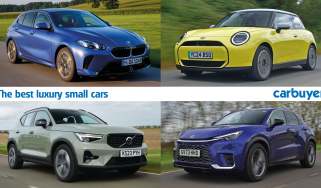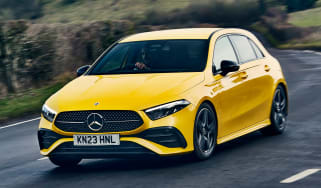Mercedes A-Class review - MPG, running costs & CO2
"The Mercedes A-Class offers decent economy and emissions figures, but insurance and servicing could be pricey"
With its lighter construction, improved aerodynamics and up-to-date engines, this A-Class is more economical and emits less CO2 than the previous model. There are several engines to choose from, all of which return figures that stack up fairly well against premium rivals. Mercedes still offers a diesel option – a growing rarity in hatchbacks – by way of its A 200 d model, and it’s one of the most frugal of the range, capable of 57.7mpg. Petrol Mercedes A-Class models offer relatively attractive economy and emissions figures, too, thanks to new mild-hybrid technology introduced for the latest model.
The A-Class is also available as a plug-in hybrid, known as the A 250 e, with an impressive all-electric range of up to 53 miles making it more than capable of running on electricity for multiple short trips.
Mercedes A-Class MPG & CO2
Currently, the 148bhp 2.0-litre A 200 d is the most frugal non-hybrid choice; economy is a claimed 57.7mpg – a figure that’s similar to the equivalent Audi A3 and BMW 1 Series, but around 10mpg behind the Volkswagen Golf’s official figure. The now-discontinued SE had smaller wheels and was slightly more economical, while sporty AMG Line versions with big wheels are a little less frugal. The A 200 d sits in similar Benefit-in-Kind (BiK) bands as the petrol models for company car drivers.
More reviews
Car trim reviews
In-depth reviews
- Mercedes A-Class review – a comfort-focused premium hatchback
- Mercedes-AMG A 45 review – a powerful, but pricey hot hatch
- Mercedes A-Class saloon review
- Mercedes A 250 e hatchback review
Used car reviews
Of the petrol options, the 160bhp, 1.3-litre A 200 offers the best blend of performance, economy and emissions – in fact, it’s more economical and yet quicker than rivals such as the DS4. An official figure of 47.9mpg takes into account the 17-inch wheels on the Sport Executive model, and the A 200 emits a CO2 figure of 135-137g/km. Opting for 18-wheels doesn't adversely affect the economy or emissions figures.
The A 250 e plug-in hybrid uses a turbocharged 1.3-litre petrol engine in combination with an electric motor to give it 215bhp. With a claimed pure-electric driving range of up to 53 miles, the A 250 e is officially the most efficient model in the range with a claimed official economy figure of well over 250mpg. It’s also the greenest, emitting sub-30g/km of CO2, which puts it in the lowest BiK banding for company-car drivers.
The A 250 e can be charged from 10-100% in under two hours using a 7.4kW wallbox, making it easy to charge at home or at the office. For the facelift, it can also be recharged at up to 11kW AC, cutting recharge times where available.
The most powerful engines are unsurprisingly the least economical, but not by a huge margin. The 302bhp, 2.0-litre A 35 AMG returns a claimed 33.2mpg on average and emits 184-193g/km of CO2. The result is a high first-year tax payment, although this will be included in the car’s on-the-road price. The A 35 and A 45 S also hit the top BiK rate for company-car users but the extra performance should be worth the additional tax if you value a sportier drive.
VED (road tax) for all models (after the first year's CO2-weighted payment at purchase time) is charged at the standard rate, while the hybrid gets a small discount. You could spec an A-Class to over £40,000 with a few options, so models over this threshold are subject to the extra surcharge in years two to six.
Insurance groups
The A-Class isn't the cheapest hatchback to insure, with groups starting from 20 for the A 180 and 40 for the most powerful A 45 AMG. The Volkswagen Golf sits in groups as low as 14 for the entry petrol Life trim.The A-Class isn't the cheapest hatchback to insure, with groups starting from 20 for the A 180 and 40 for the most powerful A 45 AMG. The Volkswagen Golf sits in groups as low as 14 for the entry petrol Life trim.
Warranty
As with all Mercedes cars, the A-Class is covered by an unlimited-mileage/three-year warranty, including ‘Mercedes Roadside Assistance’ for the duration. This is matched by the warranty offered on new BMWs, but better than Audi's 60,000-mile/three-year guarantee with roadside assistance.
Servicing
Mercedes offers a flexible servicing plan called ServiceCare, which allows buyers to spread the cost of servicing across a series of payments, or simply make a one-off payment. Mercedes guarantees its parts and labour for "up to three years".
















